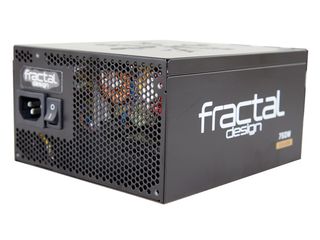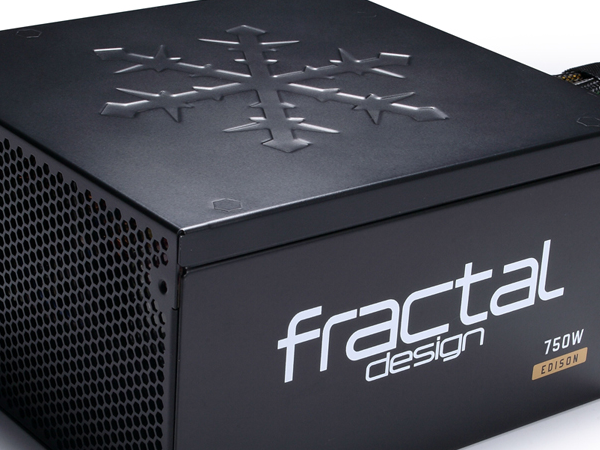Early Verdict
The Edison M Series 750 W PSU is a solid performer, with quality components; a good FDB fan; and a long, five-year warranty. However, the fan can be noisy under tough conditions, and at this price, there are many PSU choices with equal performance and efficiency levels.
Pros
- +
• Delivered full power at 48 degrees C (118 degrees Fahrenheit) • Low ripple (except 5V) • FDB fan • Japanese caps • Five-year warranty • Compact dimensions • Six PCIe connectors
Cons
- -
• High price • High inrush current • Noisy under tough conditions • Ripple at 5V at higher loads
Why you can trust Tom's Hardware
Introduction
Up until now, Fractal Design cooperated with ATNG for its higher-end PSU offerings. Although ATNG is a lesser-known original equipment manufacturer (OEM), it has a reputation for making high-quality products. The latest PSU line from Fractal Design, called Edison M, or simply Edison, is made by Seasonic, a prolific OEM with lots of experience in this field. Seasonic is responsible for some of the best PSUs money can buy today. The Edison series consists of four units with capacities ranging from 450 to 750W, covering mainstream and mid-level outputs.

All Edison units use a semi-modular cabling design and meet the 80 PLUS Gold requirements, since they are based on the same platform as Seasonic's G-series PSUs. This is an affordable mid-range platform designed to satisfy users who aren't after top performance, but want a product with a high performance-per-dollar ratio.
Today we're evaluating the most powerful member of the Edison family, which delivers up to 750W. That's enough to cover the needs of two high-end graphics cards along with the system components to support them. Because the Edison units are based on a platform proven to be reliable, Fractal Design backs them up with a five-year warranty. Seasonic is known to use good-quality capacitors and fans in its implementations, so providing a long-term warranty doesn't involve a high risk. In a typical PSU, there are two things that are most likely to go wrong: the electrolytic caps used in the APFC converter stage and in the secondary side, and the cooling fan. The fan can be fatal for the PSU's longevity, especially if it doesn't have Over-Temperature Protection (OTP). Before it completely stops working, you might notice weird sounds or simply more noise. Ball-bearing fans especially get louder as their bearings start to fail, which is a good indication that a replacement is needed. On the other hand, the plain sleeve-bearing fans might not provide enough clues before they break down; besides that, they have a significantly shorter lifetime compared with ball-bearing fans.
Specifications
The efficiency of this PSU is Gold-rated and the cabling design is semi-modular. We would prefer fully modular cabling, but obviously this would increase the unit's cost. According to Seasonic, the platform can deliver full power continuously at 40 degrees Celsius; at 50 °C it can deliver 80 percent of the max-rated load. We expected that there would be no limitation with 50 °C in power delivery, since the same platform used in the Seasonic G units delivers full power at 50 °C effortlessly. We'll have to take a thorough look at this unit's internals to find out why the full power was lowered.
The PSU’s cooling fan uses a Fluid Dynamic Bearing (FDB), which is an upgraded sleeve-bearing type offering a much longer lifetime along with silent operation. Currently, FDB fans are considered the best since they match (and in many cases exceed) the lifetime of ball-bearing fans. They also don't have the typical problems seen in ball-bearing fans, including increased noise once their bearings start to wear out. The fan-control circuit doesn't include a semi-passive mode like Seasonic's high-end PSUs; however, as long as it keeps the fan at low speeds under light loads, we don't believe that this is a downside. On the contrary, we aren't big fans of semi-passive operation since it allows for increased heat build-up at the internals, applying unnecessary stress to sensitive components like electrolytic caps. Finally, the PSU is compatible with the newer ATX v.2.4 guideline, which automatically means that it is Haswell-ready.
Power Specifications
| Rail | 3.3V | 5V | 12V | 5VSB | -12V | |
|---|---|---|---|---|---|---|
| Max. Power | Amps | 20 | 20 | 62 | 2.5 | 0.3 |
| Watts | 100 | 744 | 12.5 | 3.6 | ||
| Total Max. Power (W) | Row 2 - Cell 1 | Row 2 - Cell 2 | 750 | Row 2 - Cell 4 | Row 2 - Cell 5 |
The minor rails on the Edison M PSU are restricted to 100W, which is enough for every modern system that can be supported by a PSU with up to 750W. The single +12V rail, on the other hand, is pretty powerful with 62A max current output. Finally, the 5VSB rail has the typical capacity for a mid-range PSU.
Cables And Connectors
| Native Cables | |
|---|---|
| ATX connector (540mm) | 20+4 pin |
| 4+4 pin EPS12V (700mm) | 1 |
| 6+2 pin PCIe (590mm+100mm) | 2 |
| Modular Cables | |
| 4+4 pin EPS12V (680mm) | 1 |
| 6+2 pin PCIe (550mm+100mm) | 4 |
| SATA (385mm+115mm+115mm+115mm) | 8 |
| SATA (650mm+120mm) | 2 |
| Four-pin Molex (400mm+120mm+120mm) | 3 |
| Four-pin Molex (300mm+120mm) | 2 |
| FDD adapter (+100mm) | 1 |
You can have either four PCIe connectors with a pair of EPS connectors, or a single EPS plug with six PCIe connectors. Given this unit's capacity, we believe that this is a fair compromise, since six PCIe and two EPS connectors can easily draw more than 750W if they are attached to power-hungry components. The quantity of the other connectors is pretty high for the capacity of this PSU.
All of the cables are long enough, with the EPS ones reaching 70 centimeters, so even in full tower cases there won’t be any problems. In addition, the distance between the SATA connectors is adequate. However, a longer run between the peripheral (four-pin) connectors would be preferable. Fractal Design also includes an FDD adapter, which can come in handy in some rare cases. Finally, all cables use standard 18AWG wires.
Power Distribution
Since this PSU features a single +12V rail, we do not have a comment about its power distribution.

Aris Mpitziopoulos is a contributing editor at Tom's Hardware, covering PSUs.
-
maxwellmelon there are several issues with there testing. first power good signal is not a good base for testing as its simple to "Cheat" the 16ms hold up.how about actually watching power good vs output voltages also. also the thermal camera scall changes every time how about using a fix scale as modifying scales leads to making things show hot that are not really that hot.Reply -
Aris_Mp First of all I measure AC loss to PWR_OK hold-up time since it is much easier to show it in my graphs and explain it. For me it is as easy to measure "AC loss to PWR_OK hold-up time" plus "PWR_OK inactive to DC loss delay" but I prefer it the way I do it.Reply
Also where do you base this? That the PG signal is simple to cheat and the manufacturers actually do this? From the moment the mainboards take seriously into account PG if this was the case then most likely there would be huge problems with lots of them. According to the ATX spec PG is de-asserted to a low state when any of the main rails falls out of 5% v. reg. Simply as that.
It just gives room for 1 ms till the PG signal sees the change at least in the ATX spec.
As for the thermal camera how it can show things hotter than it is? The scale is for this reason and from the moment the camera sees something from a different angle and a different region the scale is changing automatically. Nothing I can do about it. This is why I provide also actual temperature readings on all IR images.
-
PaulBags A quick opinion on the edison vs similar range seasonic own brand would be nice. Is it a new design, or an exact rebrand of a seasonic design? Quality of components vs?Reply -
Aris_Mp This is based on the same platform with the Seasonic G series and I state this in the "look inside" page. I haven't tested the G750 so far but I believe that since they are based on the same platform performance will be similar. Seasonic might used Enesol polymer caps (something that they usually do in their G units) instead of Chemi-Cons that Fractal chose, but both cap brands are very good so don't expect to see any real performance difference on them (although I prefer Chemi-Cons).Reply
So the design is nothing new and this is a Seasonic rebrand with minor differences at the internals (most likely the caps selection as I stated above). -
Aris_Mp Forgot to mention that besides caps the cooling fan is also different since on all Seasonic G units that I have tested so far have an ADDA double-ball bearing fan while the Edison PSU uses an FDB fan. However lately I noticed that many Seasonic units use Hong Hua FDB fans instead of ADDA double-ball bearing ones, so it is possible that this change might have affected the new bunches of G units.Reply -
Sakkura You say that you'd prefer if the unit was fully modular, but I don't really see the point.Reply
The fixed cables are the ones that will always be in use for any system using a 750W power supply, so the ability to disconnect those cables would not be beneficial. In fact it would lead to higher cost and also an extra point of failure and a slight loss of efficiency since a connector can never quite match an uninterrupted cable. -
Aris_Mp fully modular cables provide easier installation and cable management. Also you can easily change them with longer/shorter ones if you like or replace them in case there is a problem with them or simply you want something fancier.Reply
Loss of efficiency isn't a reason any more, on the contrary with bus bars or thick cables transferring power to the modular PCB energy losses can be minimized. In addition no cables block the secondary side caps, something that besides increasing their lifetime also allows for more relaxed fan profiles and better airflow inside the chassis.
Also the cost of a semi-modular to fully modular isn't high and in a 750 W PSU that costs 140 bucks already the cost reason doesn't stand (for fully modular design). -
Sakkura Reply
No they don't. The connector on the power supply end adds complexity and reduces cable flexibility.15924995 said:fully modular cables provide easier installation and cable management. Also you can easily change them with longer/shorter ones if you like or replace them in case there is a problem with them or simply you want something fancier.
You cannot easily change them because other cables are often incompatible - there is no common standard for modular PSU cables. Using incompatible cables can be downright dangerous. Here is a cautionary tale. -
Aris_Mp I didn't say that you can change them with anything, did I? Also it is common sense that every manufacturer uses their one design on modular cables. Thing is that with modular PSUs you can get an extra cable kit since most manufacturers sell one for their PSUs (e.g. Corsair, EVGA).Reply
Also I still cannot understand how the connector on the PSU end adds complexity and reduces cable flexibility! Cable flexibility depends on the gauges' thickness and not on the cables modularity design (or not).
Anyway I believe I made my opinion clear on why I prefer fully-modular PSUs.
